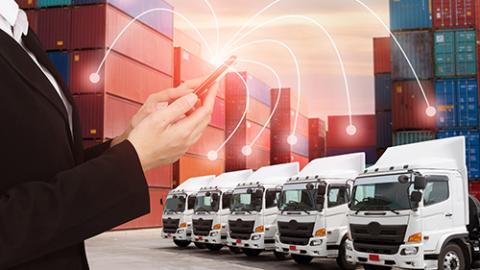How Fleet Technology Can Help Improve the Bottom Line

For grocers getting ready for the 2019 holiday season, the seamless delivery of goods to inventories, shelves and ultimately customers’ shopping carts is critical. This means making sure your supply chains, whether independent or owned, are leveraging advanced technology to protect your business and the customer experience.
GPS fleet management technology is one such technology that can help improve road safety, driver behavior and visibility, as well as your bottom line. At its core, fleet management technology leverages GPS location data to pinpoint where fleets — in this instance, deliveries — are during the day. There are myriad benefits to this data, from specifying delivery timing to rerouting in the case of bad weather or adverse road conditions.
Moreover, advanced fleet management software can be paired with sensors that provide data on inventory temperature, tilt, vibration, shock, humidity, light and pressure, constantly monitoring goods to verify that they stay in the correct low-temperature range and remain safe during transport.
Advanced fleet management technology can help improve your bottomline not only during the upcoming winter holidays, but also year-round. Here are three ways that this technology can be beneficial:
1. Help promote quality cargo and reduce waste
This means grocers must be cognizant of safely transporting food and preventing any damage that could result in wasted cargo and foodborne illness from contaminated products.
In both situations, gaining visibility into the transport of goods is important for compliance and helps freight and delivery companies avoid fines and reduce wasted trips and rejected deliveries.
In the past, traditional food transport relied on manual checks to reefer containers that required road stops to make safe-temperature checks. Today, fleet management technology can help enable near-real-time monitoring, logging and temperature alerts from container sensors.
Fleet managers and drivers can more easily check the status of inventory throughout the delivery. This not only helps reduce the number of interruptions for drivers and improves engine idle time, but it can also make it easier to maintain the highest-quality inventory when it reaches its destination and consumers.
2. Help improve efficiency
Companies across industries ask the same question: How can we be more efficient? This is especially true in the grocery industry, where consistency is king. Keeping shelves stocked requires managing and coordinating specific delivery days, time windows and preferred customer/driver combinations.
With route optimization software, fleet managers can create more strategic routes that improve a driver’s day. Smarter routes can help decrease the overall number of routes, save on fuel and balance the workload across drivers.
The routing capabilities of fleet management software can also help when the unpredictable happens, from weather and traffic, to road closures. Fleet management technology can help give fleet managers visibility during the day to quickly alert drivers and adjust their routes to promote timely delivery.
Within fleet management software, weather and traffic conditions overlay the GPS location of vehicles and trucks to help provide fleet managers with information that can help them make decisions when the unexpected happens. This added visibility can help protect drivers, vehicles and inventory, and can help limit delays and improve overall efficiency.
3. Help lower insurance costs
For grocers managing their own supply chains and delivery vehicles, location data from fleet management software can help provide necessary information on delivery timing and, in the event of an accident, necessary context. This information can be used for insurance and claim purposes.
For instance, fleet managers can negotiate rates and discounts by using driver performance and vehicle use reports through the software. These results are important to keep drivers and assets safe, and they also illustrate how a company is taking the initiative to help prevent future accidents.
Beyond safety key performance indicators (KPIs) and results, GPS tracking can also help reduce vehicle theft and unauthorized vehicle usage, and provide proof of compliance, all of which can affect insurance costs.
Fleet management technology can ultimately provide businesses with additional tools and insights that can help strengthen business performance and protect the bottom line. And as fleet management software evolves with the addition of video data and increased processing capacity, it will open up even more ways that business owners can use and share GPS tracking data in the supply chain.







